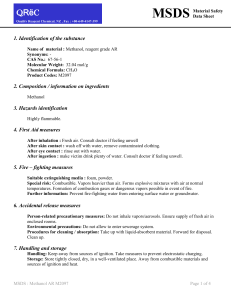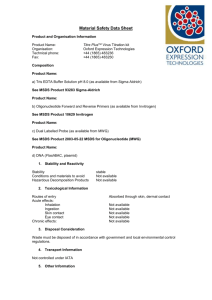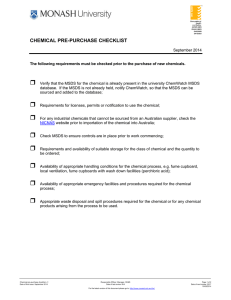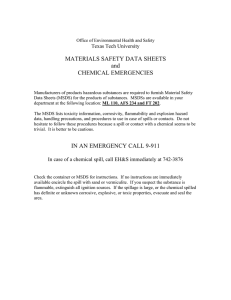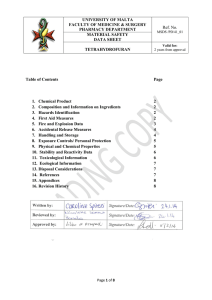Ref. No. UNIVERSITY OF MALTA FACULTY OF MEDICINE & SURGERY PHARMACY DEPARTMENT
advertisement
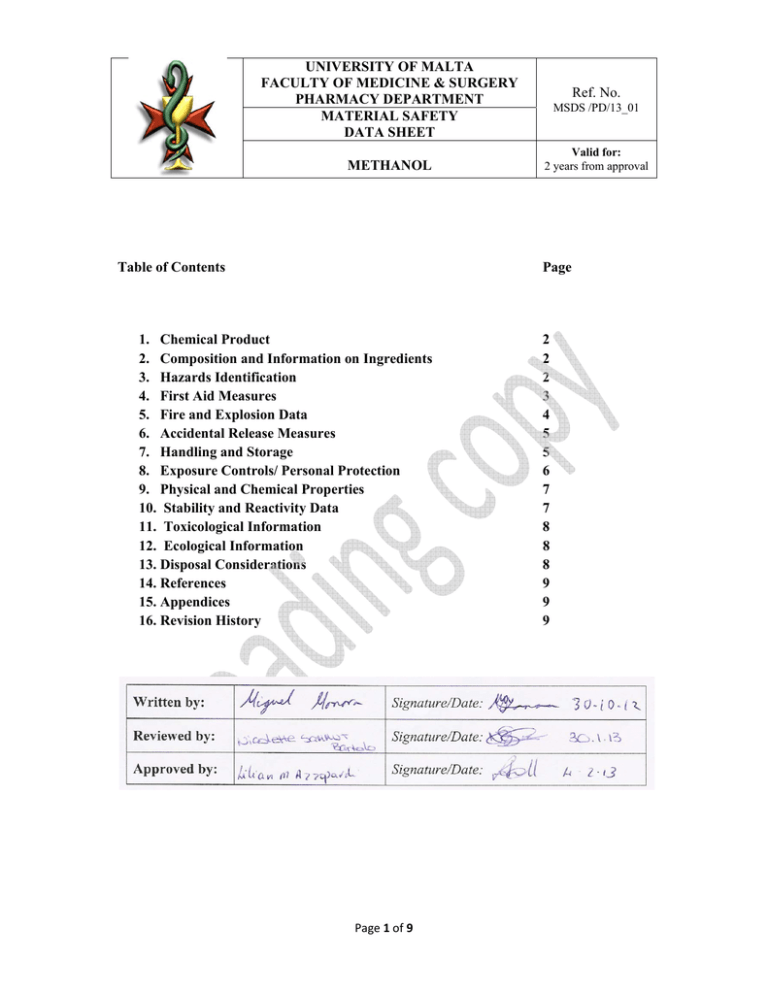
UNIVERSITY OF MALTA FACULTY OF MEDICINE & SURGERY PHARMACY DEPARTMENT MATERIAL SAFETY DATA SHEET METHANOL Table of Contents Valid for: 2 years from approval Page 1. Chemical Product 2. Composition and Information on Ingredients 3. Hazards Identification 4. First Aid Measures 5. Fire and Explosion Data 6. Accidental Release Measures 7. Handling and Storage 8. Exposure Controls/ Personal Protection 9. Physical and Chemical Properties 10. Stability and Reactivity Data 11. Toxicological Information 12. Ecological Information 13. Disposal Considerations 14. References 15. Appendices 16. Revision History Page 1 of 9 Ref. No. MSDS /PD/13_01 2 2 2 3 4 5 5 6 7 7 8 8 8 9 9 9 UNIVERSITY OF MALTA FACULTY OF MEDICINE & SURGERY PHARMACY DEPARTMENT MATERIAL SAFETY DATA SHEET METHANOL Ref. No. MSDS /PD/13_01 Valid for: 2 years from approval Chemical Product 1. Product Name: Methyl alcohol Chemical name: Methanol Synonyms: Wood alcohol, Methanol; Methylol; Wood Spirit; Carbinol Chemical Formula: CH3OH 2. Composition and Information on Ingredients Composition: 100% methanol by weight Toxicological Data on Ingredients: Methyl alcohol: ORAL (LD50): Acute: 5628 mg/kg [Rat]. DERMAL (LD50): Acute: 15800 mg/kg [Rabbit]. VAPOR (LC50): Acute: 64000 ppm 4 hours [Rat]. 3. Hazards Identification Potential Acute Health Effects: Hazardous in case of skin contact (irritant), eye contact (irritant), ingestion and inhalation. Slightly hazardous in case of skin contact (permeator). Severe over-exposure can result in death. Potential Chronic Health Effects: Slightly hazardous in case of skin contact (sensitizer). CARCINOGENIC EFFECTS: N/A MUTAGENIC EFFECTS: Mutagenic for mammalian somatic cells. Mutagenic for bacteria and/or yeast. TERATOGENIC EFFECTS: Classified POSSIBLE for human. DEVELOPMENTAL TOXICITY: N/A. The substance is toxic to the eyes, and may be toxic to blood, kidneys, liver, brain, peripheral nervous system, upper respiratory tract, skin, central nervous system (CNS) and optic nerve. Repeated or prolonged exposure to the substance can produce target organs damage. Repeated exposure to a highly toxic material may produce general deterioration of health by an accumulation in one or many human organs. Page 2 of 9 UNIVERSITY OF MALTA FACULTY OF MEDICINE & SURGERY PHARMACY DEPARTMENT MATERIAL SAFETY DATA SHEET 4. METHANOL Ref. No. MSDS /PD/13_01 Valid for: 2 years from approval First Aid Measures General measures: N/A Skin contact: In case of contact, immediately flush skin with plenty of water for at least 15 minutes while removing contaminated clothing and shoes. Cover the irritated skin with an emollient. Cold water may be used. Wash clothing before reuse and thoroughly clean shoes before reuse. Get medical attention immediately. Serious skin contact: Wash with a disinfectant soap and cover the contaminated skin with an anti-bacterial cream. Seek immediate medical attention. Eye contact: Check for and remove any contact lenses and immediately flush eyes with running water for at least 15 minutes, keeping eyelids open. Cold water may be used. Get medical attention. Ingestion: If swallowed, do not induce vomiting unless directed to do so by medical personnel. Never give anything by mouth to an unconscious person. Loosen tight clothing such as a collar, tie, belt or waistband. Get medical attention immediately. Serious indigestion: N/A Inhalation: If inhaled, remove to fresh air. If not breathing, give artificial respiration. If breathing is difficult, give oxygen. Get medical attention immediately. Serious inhalation: Evacuate the victim to a safe area as soon as possible, loosening tight clothing such as a collar, tie, belt or waistband. If breathing is difficult, administer oxygen. If the victim is not breathing, perform mouth-to-mouth resuscitation. WARNING: It may be hazardous to the person providing aid to give mouth-to-mouth resuscitation when the inhaled material is toxic, infectious or corrosive. Seek immediate medical attention. Page 3 of 9 UNIVERSITY OF MALTA FACULTY OF MEDICINE & SURGERY PHARMACY DEPARTMENT MATERIAL SAFETY DATA SHEET 5. METHANOL Ref. No. MSDS /PD/13_01 Valid for: 2 years from approval Fire and Explosion Data Flammability of the Product: Flammable. Auto-Ignition Temperature: 464°C (867.2°F) Flash points: CLOSED CUP: 12°C (53.6°F). OPEN CUP: 16°C (60.8°F) Flammable limits: LOWER: 6% UPPER: 36.5% Products of Combustion: These products are carbon oxides (CO, CO2). Fire Hazards in Presence of Various Substances: Highly flammable in presence of open flames and sparks, of heat. Non-flammable in presence of shocks. Explosion Hazards in Presence of Various Substances: − Risks of explosion of the product in presence of mechanical impact: N/A. − Explosive in presence of open flames and sparks, of heat. Fire fighting media and Instructions: Flammable liquid, soluble or dispersed in water. SMALL FIRE: Use DRY chemical powder. LARGE FIRE: Use alcohol foam, water spray or fog. Special Remarks on Fire Hazards: Explosive in the form of vapour when exposed to heat or flame. Vapour may travel considerable distance to source of ignition and flash back. When heated to decomposition, it emits acrid smoke and irritating fumes. CAUTION: MAY BURN WITH NEAR INVISIBLE FLAME Special Remarks on Explosion Hazards: Forms an explosive mixture with air due to its low flash point. Explosive when mixed with Choroform + sodium methoxide and diethyl zinc. It boils violently and explodes. Page 4 of 9 UNIVERSITY OF MALTA FACULTY OF MEDICINE & SURGERY PHARMACY DEPARTMENT MATERIAL SAFETY DATA SHEET 6. METHANOL Ref. No. MSDS /PD/13_01 Valid for: 2 years from approval Accidental Release Measures NB: Wear appropriate protective equipment/clothing including gloves before removing any spills. Small spill: Dilute with water and mop up, or absorb with an inert dry material and place in an appropriate waste disposal container. Large spill: Flammable, poisonous liquid. Keep away from heat and sources of ignition. Stop leak if without risk. Absorb with DRY earth, sand or other non-combustible material. Do not get water inside container and do not touch spilled material. Use water spray to reduce vapours. Prevent entry into sewers, basements or confined areas; dike if needed. Call for assistance on disposal. Be careful that the product is not present at a concentration level above TLV. Check TLV on the MSDS and with local authorities. 7. Handling and Storage Precautions: Keep locked up and away from heat or sources of ignition. Ground all equipment containing material. Do not ingest or breathe gas/fumes/ vapour/spray. Wear suitable protective clothing. In case of insufficient ventilation, wear suitable respiratory equipment. If ingested, seek medical advice immediately and show the container or the label. Avoid contact with skin and eyes. Keep away from incompatibles such as oxidizing agents, metals, acids. Storage: Store in a segregated and approved area. Keep container in a cool, well-ventilated area. Keep container tightly closed and sealed until ready for use. Avoid all possible sources of ignition (spark or flame). Page 5 of 9 UNIVERSITY OF MALTA FACULTY OF MEDICINE & SURGERY PHARMACY DEPARTMENT MATERIAL SAFETY DATA SHEET METHANOL Ref. No. MSDS /PD/13_01 Valid for: 2 years from approval 8. Exposure Controls/Personal Protection Airborne Exposure Limits: − TWA: 200 from OSHA (PEL) [United States] − TWA: 200 STEL: 250 (ppm) from ACGIH (TLV) [United States] [1999] STEL: 250 − from NIOSH [United States] − TWA: 200 STEL: 250 (ppm) from NIOSH SKIN − TWA: 200 STEL: 250 (ppm) [Canada] − Consult local authorities for acceptable exposure limits. Engineering Controls: Provide exhaust ventilation or other engineering controls to keep the airborne concentrations of vapours below their respective threshold limit value. Ensure that eyewash stations and safety showers are proximal to the work-station location. Personal Protection: Splash goggles, lab coat, gloves, and vapour respirator, making sure to use an approved/certified respirator or equivalent.. Page 6 of 9 UNIVERSITY OF MALTA FACULTY OF MEDICINE & SURGERY PHARMACY DEPARTMENT MATERIAL SAFETY DATA SHEET 9. METHANOL Ref. No. MSDS /PD/13_01 Valid for: 2 years from approval Physical and Chemical Properties Physical state and appearance: Colourless liquid Odour: Alcohol like. Pungent when crude. Taste: N/A Molecular Weight: 32.04 g/mole pH (1% solution/water): N/A Boiling Point: 64.5°C (148.1°F) Melting Point: -97.8°C (-144°F) Critical Temperature: 240°C (464°F) Specific Gravity (Water = 1): 0.7915 Vapour Pressure (mmHg): 12.3 kPa (@ 20°C) Vapour Density: 1.11 (Air = 1) Volatility: N/A Odour Threshold: 100 ppm Water/Oil Distribution Coefficient: The product is more soluble in water; log(oil/water) = 0.8 Ionicity (in Water): Non-ionic Dispersion Properties: See solubility in water Solubility: Easily soluble in cold water, hot water. Stability and Reactivity Data 10. Stability: The product is stable. Corrosivity: Non-corrosive in presence of glass. Instability temperature: N/A Conditions of Instability: Heat, ignition sources, incompatible materials. Can react vigorously with oxidizers. Violent reaction with alkyl aluminum salts, acetyl bromide, chloroform + sodium methoxide, chromic anhydride, cyanuirc chlorite, lead perchlorate, phosphorous trioxide, nitric acid. Exothermic reaction with sodium hydroxide + chloroform. Incompatible with beryllium dihydride, metals (potassium and magnesium), oxidants (barium perchlorate, bromine, sodium hypochlorite, chlorine, hydrogen peroxide), potassium tertbutoxide, carbon tetrachloride, alkali metals, metals (aluminum, potassium magnesium, zinc), and dichlormethane. Rapid autocatalytic dissolution of aluminum, magnesium or zinc in 9:1 methanol + carbon tetrachloride - sufficiently vigorous to be rated as potentially hazardous. May attack some plastics, rubber, and coatings. Incompatibles: Reactive with oxidizing agents, metals, acids. Polymerization: Will not occur. Page 7 of 9 UNIVERSITY OF MALTA FACULTY OF MEDICINE & SURGERY PHARMACY DEPARTMENT MATERIAL SAFETY DATA SHEET 11. METHANOL Ref. No. MSDS /PD/13_01 Valid for: 2 years from approval Toxicological Information Toxicity to animals: WARNING: THE LC50 VALUES HEREUNDER ARE ESTIMATED ON THE BASIS OF A 4-HOUR EXPOSURE. Acute oral toxicity (LD50): 5628 mg/kg [Rat]. Acute dermal toxicity (LD50): 15800 mg/kg [Rabbit]. Acute toxicity of the vapour (LC50): 64000 4 hours [Rat]. Effects on humans: Acute potential health effects: N/A Chronic potential health effects: Passes through the placental barrier. May affect genetic material. May cause birth defects and adverse reproductive effects (paternal and maternal effects and foetotoxicity ) based on animal studies. MUTAGENIC EFFECTS: Mutagenic for mammalian somatic cells. Mutagenic for bacteria and/or yeast. TERATOGENIC EFFECTS: Classified POSSIBLE for human. Causes damage to the following organs: eyes. May cause damage to the following organs: blood, kidneys, liver, brain, peripheral nervous system, upper respiratory tract, skin, central nervous system (CNS) and optic nerve. DEVELOPMENTAL TOXICITY: N/A Other information: Hazardous in case of skin contact (irritant), of ingestion, of inhalation. Slightly hazardous in case of skin contact (permeator). 12. Ecological Information Ecotoxicity: Ecotoxicity in water (LC50): 29400 mg/l 96 hours [Fathead Minnow] 13. Disposal Considerations Waste Disposal: Waste must be disposed of in accordance with local environmental control regulations. Page 8 of 9 UNIVERSITY OF MALTA FACULTY OF MEDICINE & SURGERY PHARMACY DEPARTMENT MATERIAL SAFETY DATA SHEET 14. Ref. No. MSDS /PD/13_01 Valid for: 2 years from approval METHANOL References − Sciencelab.com. Material Safety Data Sheet; Ethyl Acetate, MSDS [Online] 2005 [cited 2012 Oct 30]. Available from: URL: http://www.sciencelab.com/msds.php?msdsId=9927227 − Methanol.org. Material Safety Data Sheet; Ethyl Acetate, MSDS [Online] 2011 [cited 2012 Oct 30]. Available from: URL: http://methanol.org/Environment/Resources/Environment/MX-Methanol-MSDS-USEnglish-FINAL-Sept08.aspx − Southernchemical.com. Material Safety Data Sheet; Ethyl Acetate, MSDS [Online] 2012 [cited 2012 Oct 30]. Available from: URL: http://www.southernchemical.com/wp/pdf/SCC%20MSDS%20English.pdf 15. Appendices N/A 16. Revision History Version Number Amendments/ Reasons for change 01 Initial Release Page 9 of 9
